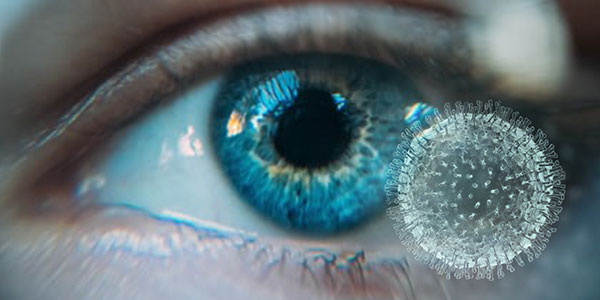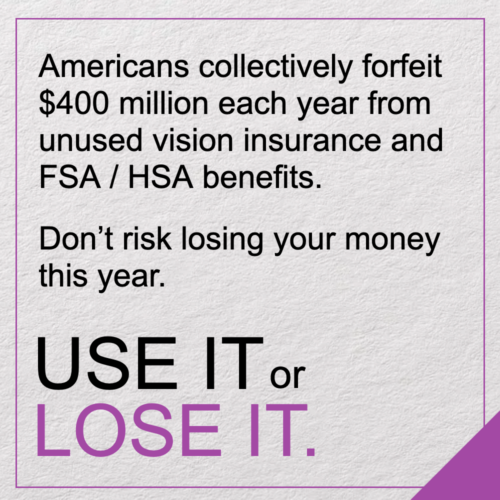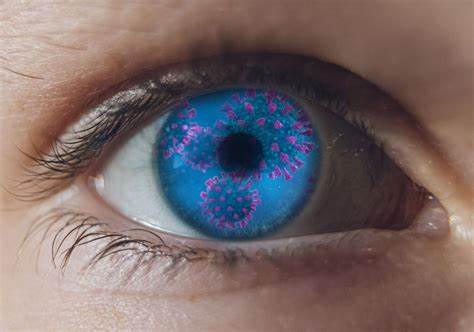COVID-19, caused by the SARS-CoV-2 virus, is known for its respiratory symptoms, but it can also affect your eyes, similar to other adenoviruses that infect the eye tissue. COVID-19 conjunctivitis, also referred to as “COVID Eye”, remains the most common sign of COVID in the eyes of children and adults. It can impact your eye health, as it can lead to various ocular symptoms and even long-term complications.
COVID-19 Conjunctivitis
COVID Eye is an inflammation of the conjunctiva—the thin, transparent layer of tissue that covers the white part of the eye and the inside of the eyelids. This condition occurs when the virus infects the eye, leading to symptoms such as redness, watering, irritation, and a gritty feeling, similar to other types of viral conjunctivitis. It can occur alone or before other respiratory symptoms, making it important to recognize it as a potential sign of COVID-19 infection.
While COVID-19 conjunctivitis is generally mild, it can serve as an early indicator of the virus, especially if it appears without other common COVID-19 symptoms like cough or fever. This condition spreads through direct contact with infected droplets or surfaces, making proper hygiene and avoiding touching your eyes essential preventive measures. Although conjunctivitis usually resolves on its own, seeking medical advice is crucial if you suspect it’s related to COVID-19 to manage symptoms effectively and prevent further spread.
How COVID-19 Infects the Eye
COVID-19 infects the eye in a manner similar to other adenoviruses that cause conjunctivitis (commonly known as pink eye). The virus can enter through the mucous membranes, which include the eyes, nose, and mouth. The tear ducts, which connect the eyes to the nasal cavity, provide a direct pathway for the virus to travel from the eyes into the respiratory system and vice versa. This means that the virus can not only enter the body through the eyes but also spread within the body, potentially leading to ocular symptoms.
The surface of the eye, including the conjunctiva, has ACE2 receptors, which are the same receptors the virus uses to enter respiratory cells. Once the virus binds to these receptors, it can cause inflammation, leading to various symptoms in the eyes. Additionally, touching the eyes with contaminated hands can introduce the virus directly, making eye protection and hygiene crucial during the pandemic.
Common Signs and Symptoms of COVID Eye
COVID Eye can cause a range of symptoms in the eyes, ranging from mild to severe. The most common eye-related symptom reported is viral conjunctivitis, which can present with redness, swelling, tearing, and a gritty sensation in the eyes. Other symptoms include:
- Red Eyes: Inflammation and irritation can cause the eyes to appear bloodshot or pink.
- Watery Eyes: Increased tear production is often seen in conjunction with conjunctivitis.
- Eye Pain or Discomfort: Some patients report soreness, itching, or a feeling of pressure around the eyes.
- Blurred Vision: Swelling and inflammation can lead to temporary changes in vision clarity.
- Light Sensitivity (Photophobia): Inflamed eyes may become more sensitive to light, causing discomfort in bright environments.
- Dry Eyes: Reduced tear film stability may lead to feelings of dryness, irritation, and a foreign body sensation.
- Eyelid Swelling: The eyelids may become puffy and tender due to inflammation.
- Eye Discharge: A clear or sticky discharge may accompany conjunctivitis, often causing the eyes to stick shut, particularly in the morning.
While these symptoms can be directly caused by the virus, they can also be secondary to the overall inflammatory response of the body during infection.

Long-Term Complications of COVID Eye
Though most symptoms associated with COVID Eye are mild and self-limiting, there are potential long-term complications, especially in severe cases or when the virus directly infects the eye tissues. These complications include:
- Chronic Dry Eye Syndrome: Persistent inflammation can disrupt tear production and eye surface stability, leading to chronic dry eye symptoms that may require ongoing management.
- Uveitis: COVID-19 has been linked to uveitis, an inflammation of the middle layer of the eye, which can cause severe pain, blurred vision, and sensitivity to light. If not properly treated, uveitis can result in vision loss.
- Retinal Complications: There have been reports of retinal vascular occlusions, where the blood vessels in the retina become blocked, potentially leading to sudden vision changes or loss.
- Optic Neuritis: Inflammation of the optic nerve can lead to vision impairment and even blindness in severe cases. While rare, optic neuritis associated with COVID-19 is a serious condition that requires immediate medical attention.
- Increased Risk of Eye Infections: The virus can weaken the body’s overall immune response, making the eyes more susceptible to bacterial or fungal infections, which can exacerbate existing eye conditions.
Importance of Early Detection and Eye Care
Regular eye exams have become even more critical during the pandemic. Eye doctors can detect subtle signs of COVID eye conditions early, allowing for prompt intervention and management. Advanced imaging technologies, such as Optical Coherence Tomography (OCT) and retinal photography, are instrumental in identifying retinal changes that could be linked to COVID-19, enabling eye care professionals to tailor treatment plans effectively.
Patients who have had COVID-19 should be aware of any changes in their vision or eye comfort and seek professional evaluation if they experience persistent symptoms. Preventive eye care and maintaining good eye hygiene, such as avoiding touching the eyes and using protective eyewear when necessary, can help reduce the risk of eye complications from COVID-19.
Prevention Tips for COVID Eye Safety
To minimize the risk of contracting COVID-19 through the eyes, consider the following preventive measures:
- Wear Glasses or Protective Eyewear: While not as effective as masks, glasses can act as a barrier and reduce the likelihood of touching the eyes.
- Avoid Touching Your Eyes: Wash your hands frequently, and avoid rubbing or touching your eyes, especially in public places.
- Maintain Good Contact Lens Hygiene: If you wear contact lenses, ensure that you follow strict hygiene practices, including washing hands before handling lenses and disinfecting them properly.
- Stay Up-to-Date with Eye Exams: Regular eye exams can help monitor any changes and ensure that eye conditions are caught early.
Stay Informed and Proactive About Eye Health
COVID-19’s impact on eye health is an evolving area of study, but current evidence suggests that the virus can indeed affect the eyes, either directly or as part of the body’s systemic inflammatory response. By staying vigilant, maintaining regular eye care, and taking preventive measures, you can protect your eyes and overall health. Whether you have experienced eye symptoms during COVID-19 or are concerned about potential long-term effects, consulting with an eye care professional is essential for maintaining optimal eye health.
Regular eye exams and awareness of eye health are key components of comprehensive healthcare, especially during a global pandemic. Stay informed, protect your eyes, and prioritize your vision health in every way possible.
At Optical Illusions: An Optometric Practice, we prioritize your eye health and provide the best voted eye exams. Our experienced optometrists and paraoptometrics use state-of-the-art technology to determine your eye health. Contact our team to schedule your appointment at 1 of our 4 conveniently located offices using your VSP insurance benefits.




